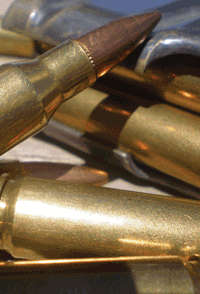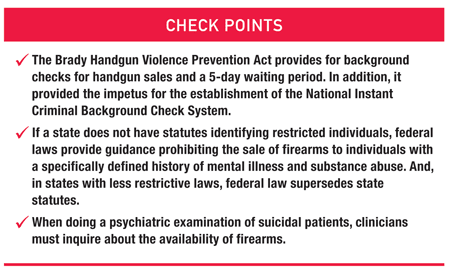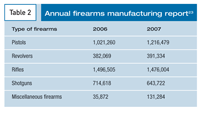Publication
Article
Psychiatric Times
Firearms and Mental Illness
Author(s):
While violence is often portrayed in the media as related to persons with mental illnesses, there are limited research data to support this idea. This article reviews laws and obligations for mental health professionals.

The right of American citizens to own, register, and carry firearms has a significant history of federal and/or local regulation dating to the early 18th century.1 With the passage of the federal Gun Control Act of 1968, persons who have been treated for mental illness and/or substance abuse are among a defined group restricted from owning and carrying firearms.2-4 While violence is often portrayed in the media as related to persons with mental illnesses, there are limited research data to support this idea.5
In the past several decades, US firearms legislation has followed high-profile instances of violent acts. The shootings of President Reagan and James Brady in 1981 resulted in the passage and implementation of the Brady Handgun Violence Prevention Act (1994). This Act provides for background checks for handgun sales and a 5-day waiting period. In addition, it provided the impetus for the establishment of the National Instant Criminal Background Check System (NICS).6,7 With the NICS in place (voluntarily by the states), the Federal Bureau of Investigation (FBI) can potentially receive information within minutes as to whether the purchase violates any federal or state laws.
State and federal regulations

A press release by the FBI dated April 9, 2007, noted that only 22 states voluntarily contribute mental health records to the NICS. The system contained only 235,000 mental health records as of January 2006, although it was estimated that 2.7 million people had been involuntarily institutionalized for mental health disorders.8 The Department of Justice noted that the law was not fully implemented because of state fiscal concerns.8 (Table 1 presents a brief overview of firearm restrictions and mental illness data banks.)
A recent review of state and federal firearm laws noted that firearm statutes vary considerably regarding ownership and/or carry restrictions and depend on the manner in which restricted individuals are defined.4,9,10 In all 50 states, as well as Puerto Rico and the District of Columbia, persons prohibited from owning and carrying firearms include those who receive outpatient psychiatric treatment, those who have been civilly committed to treatment settings, and those found not guilty by reason of insanity. Some state statutes further restrict individuals with a history of alcohol or substance abuse. If a state does not have statutes that identify restricted individuals, federal laws provide guidance for prohibiting the sale of firearms to individuals with a specifically defined history of mental illness and substance abuse. And, in states with less restrictive statutes, federal law supersedes state statutes.

In view of the large variance in state laws, it is important that psychiatrists and other physicians review the governing laws of the state or territory in which they practice if asked to provide information to the FBI or other law enforcement officials regarding a patient.
Violent acts capture the nation’s attention and often provide the impetus needed for new laws and regulations that may differentially affect persons with mental illness. In December 2005, a Virginia judge found Seung-Hui Cho, the Virginia Tech gunman, to be mentally ill and a danger to himself. He was directed to undergo outpatient treatment. Because of the judge’s adjudication of dangerousness, Cho would have met the criteria for disqualification on a federal level. However, records of the outpatient commitment were not placed into the Virginia mental health database that forwards information to the NICS. As a result, Cho was able to purchase 2 handguns.
After the shootings on April 16, 2007, that left 32 people dead, Virginia Governor Timothy Kaine issued Executive Order 50, which directed all executive branch employees to consider involuntary outpatient treatment as involuntary admission to a mental health facility (VA Code Ann §37.2-1014). The original law spoke to inpatient admission only; the new law addressed mandated outpatient treatment as well. Therefore, the names of individuals ordered into outpatient treatment would be included in the federal database. The order further directed law enforcement agents to enter records of involuntary outpatient care into the state database and to forward such records to federal law enforcement.11
The federal response to the Virginia Tech tragedy was to pass the NICS Improvement Act, which will have significant impact on persons with mental illness. It provides states with significant financial incentives to release to the Attorney General all relevant records on individuals who are prohibited by federal law from possessing firearms. The records covered include automated information needed by the NICS to identify felony convictions, felony indictments, fugitives from justice, drug arrests and convictions, prohibiting mental health adjudications and commitments, domestic violence protection orders, and misdemeanor crimes of domestic violence.12
Several states currently have specific laws addressing firearm access of individuals with mental illness and/or substance abuse and clearly define the roles of health care professionals.13-15 Connecticut laws permit legal authorities to confiscate fire-arms of individuals adjudicated to be a danger to themselves or others.
In California, persons who are admitted to a psychiatric hospital (public or private) and who are designated a danger to themselves or others must be reported to the local law enforcement agency by an attending health care professional. The reports are used to build a data bank of persons with mental illnesses and substance abuse. The legal authorities of the state are notified by the medical facility.
In Washington State, a new law broadens the firearms prohibition to include adults and youths who have 14-day commitments. Prior law mandated that the firearm prohibition only include persons who received 90-day or 180-day involuntary treatment for mental illnesses.16,17
As the public calls for increased control in matters of firearm licensure to persons with mental illnesses and to substance abusers, other states may implement similar laws and obligations for mental health professionals.
Certain provisions exist that allow persons with mental illnesses some recourse after their names are placed in a national mental health database. The federal Gun Control Act requires all federal agencies that impose mental health adjudications or commitments to provide a process for “relief from disabilities.” It prevents reporting of mental adjudications or commitments by federal agencies when those adjudications or commitments have been removed. The law further requires removal of expired, incorrect, or otherwise irrelevant records, and it provides persons with mental illness an opportunity to appeal when there has been an inappropriate commitment or finding of incompetence by a federal agency.
Firearms as instruments for suicide

Persons with mental illnesses and/or substance abuse disorders are frequently perceived by the public to be dangerous, and their inclusion in the NICS data bank is controversial. The vast majority of violent events are not perpetrated by persons with mental illness. However, there is a well-documented correlation of violence for individuals with substance abuse disorders.18,19 Thus, it is unclear whether a database of mentally ill persons is a deterrent. It is estimated that more than 40% of American households have a firearm. A recent manufacturing report from the Bureau of Alcohol, Tobacco, and Firearms evidences the growing firearms industry in this country (Table 2).
Access to firearms is an important factor for clinicians to consider in any risk assessment of suicidal patients. Miller and Hemenway20 report that “in 2005, an average of 46 Americans a day committed suicide with a firearm, accounting for 53% of all completed suicides.” Ilgen and colleagues21 used data from the National Comorbidity Survey to report on new research linking violence and mental illness. The results of their examination of the relationship between mental disorders, past suicidality, gun access, and safety practices show that persons with lifetime mental disorders were as likely as those without a mental disorder to have access to a gun, carry a gun, or store a gun in an unsafe manner. However, individuals with prior suicide attempts were less likely to have access to a firearm.
All discussions with the patient and his or her family regarding firearms should be documented. When clinicians are doing a psychiatric examination of suicidal patients, they should inquire about the availability of firearms in the household. If a firearm is available, concerns about safety should be raised with the family and police. This is particularly true when children and adolescents reside in the household.
Conclusion
Psychiatrists may have a role in the process by which their patients apply for permission to purchase, possess, or transfer a handgun, as well as in the appeals process for those with mental illness and/or alcohol or drug abuse. There is variability in the appeals process, and some states may require a 5-year period of stability before considering the application.
Some states use the concepts of the remission and stabilization of mental illness or substance abuse in their statutes and impose more clinically based expectations on the clinical documentation needed; others ask for an opinion regarding “cure” of illnesses. The legal standard of “cure” is used in some state statutes and is inconsistent with the relapsing and remitting course of many psychiatric disorders. The issue of an attestation of the patient’s “cure,” may impose potential legal liability for a patient’s future acts.
References:
References
1. Zimring FE. Firearms and federal law: the Gun Control Act of 1968. J Legal Stud. 1975;4:133-198.
2. Federal Gun Control Act, 18 USC §922 (1968), et seq.
3. Cannon A. Guns and the mentally ill. US News and World Report. April 1, 2002:22.
4. Norris DM, Price M, Gutheil T, Reid WH. Firearm laws, patients, and the roles of psychiatrists. Am J Psychiatry. 2006;163:1392-1396.
5. Appelbaum P. Violence and mental disorders: data and public policy. Am J Psychiatry. 2006;163:1319-1321.
6. Brady Act, 18 USC §922(s1-s6) (1993).
7. NICS Act Record Improvement Program. https://www.cfda.gov/index?s=program&mode=form&tab=step1&id=73b63eff9ff46fd7c8d897c8b90180c0&cck=1&au=&ck=. Assessed October 9, 2009.
8. Federal Bureau of Investigation. Response to inquires on the FBI’s National Instant Criminal Background Check System (press releases). http://www.fbi.gov/pressrel/pressrel07/nics041907.htm. Accessed October 9, 2009.
9. NRA/ILA: Gun Laws: US DOJ Letter on Interstate Firearms Transport. http://www.nraila.org/GunLaws. Accessed October 9, 2009.
10. Price M, Norris DM. National Instant Criminal Background Check Improvement Act: implications for persons with mental illness. J Am Acad Psychiatry Law. 2008;36:123-130.
11. Urbina I. Virginia ends a loophole in gun laws. New York Times. May 1, 2007. http://www.iht.com/articles/2007/05/01/news/gun.php. Accessed October 9, 2009.
12. US Department of Justice. The NICS Improvement Amendments Act of 2007. http://www.ojp.usdoj. gov/bjs/niaa.htm#NICS. Accessed October 9, 2009.
13. Cal Welf & Inst Code §8100–8105 (2004), et seq.
14. Simpson JR. Issues related to possession of firearms by individuals with mental illness: an overview using California as an example. J Psychiatr Pract. 2007;13:109-114.
15. Conn Gen Stat §29-27 (2003), et seq; 53-202 et seq; 53a-211 et seq; 17a-500 et seq.
16. Washington Legislature OKs gun restrictions for mentally ill. The Seattle Times. http://seattletimes. nwsource.com/html/localnews/2009034400_apwaxgrgunsmentallyunstable.html. Accessed October 9, 2009.
17. Wash Rev Code (ARCW) §71.05.240 (2009).
18. Wallace C, Mullen PE, Burgess P. Criminal offending in schizophrenia over a 25-year period marked by deinstitutionalization and increasing prevalence of comorbid substance use disorders. Am J Psychiatry. 2004;161:716-727.
19. Beck JC. Delusions, substance abuse, and serious violence. J Am Acad Psychiatry Law. 2004;32: 169-172.
20. Miller M, Hemenway D. Guns and suicide in the United States. N Engl J Med. 2008;359:989-991.
21. Ilgen MA, Zivin K, McCammon RJ, Valenstein M. Mental illness, previous suicidality, and acess to guns in the United States. Psychiatr Serv. 2008;59:198-200.
22. US Department of Justice. Survey of State Procedures Related to Firearm Sales, Mid-year 2003. http://www.ojp.usdoj.gov/bjs/pub/pdf/ssprfsm03.pdf. Accessed October 9, 2009.
23. Bureau of Alcohol, Tobacco, Firearms and Ex-plosives. Annual Firearms Manufacturing and Ex-port Report. http://www.atf.gov/firearms/stats/afmer/afmer2007.pdf. Assessed October 9, 2009.





